Short-Range Stacking Disorder in Mixed-Layer Compounds: A HAADF STEM Study of Bastnäsite-Parisite Intergrowths
Abstract
:1. Introduction
2. Background
3. Experimental
4. Results
4.1. Samples and Compositional Range of BSG Phases
4.2. Stacking Sequences
4.2.1. Electron Diffractions and TEM Imaging
4.2.2. HAADF STEM Imaging
5. Discussion
6. Implications and Outlook
Supplementary Materials
Acknowledgments
Author Contributions
Conflicts of Interest
References
- Ciobanu, C.L.; Cook, N.J.; Maunders, C.; Wade, B.P.; Ehrig, K. Focused Ion Beam and Advanced Electron Microscopy for Minerals: Insights and Outlook from Bismuth Sulphosalts. Minerals 2016, 6, 112. [Google Scholar] [CrossRef]
- Utsunomiya, S.; Ewing, R.C. Application of high-angle annular dark field scanning transmission electron microscopy, scanning transmission electron microscopy-energy dispersive X-ray spectrometry, and the energy-filtered transmission electron microscopy to the characterization of nanoparticles in the environment. Environ. Sci. Technol. 2003, 37, 786–791. [Google Scholar] [PubMed]
- Van Tendeloo, G.; Bals, S.; van Aert, S.; Verbeek, J.; van Dyck, D. Advanced electron microscopy for advanced materials. Adv. Mater. 2012, 24, 5655–5675. [Google Scholar] [CrossRef] [PubMed]
- Gysi, A.P.; Williams-Jones, A.E. The Thermodynamic Properties of Bastnäsite-(Ce) and Parisite-(Ce). Chem. Geol. 2015, 392, 87–101. [Google Scholar] [CrossRef]
- Guastoni, A.; Nestola, F.; Giaretta, A. Mineral Chemistry and Alteration of Rare Earth Element (REE) Carbonates from Alkaline Pegmatites of Mount Malosa, Malawi. Am. Mineral. 2009, 94, 1216–1222. [Google Scholar] [CrossRef]
- Miyawaki, R.; Yokoyama, K.; Husdal, T.A. Bastnäsite-(Nd), a new Nd-dominant member of the bastnäsite group from the Stetind pegmatite, Tysfjord, Nordland, Norway. Eur. J. Mineral. 2013, 25, 187–191. [Google Scholar] [CrossRef]
- Augé, T.; Bailly, L.; Wille, G. An Unusual Occurrence of Synchysite-(Ce) in Amygdules from the Esterel Volcanic Rocks, France: Implications for Rare-Earth Element Mobility. Can. Mineral. 2014, 52, 1–19. [Google Scholar] [CrossRef]
- Smith, M.P.; Henderson, P.; Campbell, L.S. Fractionation of the REE during Hydrothermal Processes: Constraints from the Bayan Obo Fe-REE-Nb Deposit, Inner Mongolia, China. Geochim. Cosmochim. Acta 2000, 64, 3141–3160. [Google Scholar] [CrossRef]
- Groves, D.I.; Vielreicher, N.M. The Phalabowra (Palabora) carbonatite-hosted magnetite-copper sulfide deposit, South Africa: An end-member of the iron-oxide copper-gold-rare earth element deposit group? Miner. Deposita 2001, 36, 189–194. [Google Scholar] [CrossRef]
- Ehrig, K.; McPhie, J.; Kamenetsky, V.S. Geology and mineralogical zonation of the Olympic Dam iron oxide Cu-U-Au-Ag deposit, South Australia. In Geology and Genesis of Major Copper Deposits and Districts of the World, a Tribute to Richard Sillitoe, Hedenquist, J.W., Harris, M., Camus, F., Eds. SEG Spec. Publ. 2012, 16, 237–268. [Google Scholar]
- Schmandt, D.S.; Cook, N.J.; Ciobanu, C.L.; Ehrig, K.; Wade, B.P.; Gilbert, S.; Kamenetsky, V.S. Rare earth element fluorocarbonate minerals from the Olympic Dam Cu-U-Au-Ag deposit, South Australia. Minerals 2017, 7, 202. [Google Scholar] [CrossRef]
- Kontonikas-Charos, A.; Ciobanu, C.L.; Cook, N.J.; Ehrig, K.; Krneta, S.; Kamenetsky, V.S. Feldspar Evolution in the Roxby Downs Granite, Host to Fe-Oxide Cu-Au-(U) Mineralisation at Olympic Dam, South Australia. Ore Geol. Rev. 2017, 80, 838–859. [Google Scholar] [CrossRef]
- Kontonikas-Charos, A.; Ciobanu, C.L.; Cook, N.J.; Ehrig, K.; Ismail, R.; Krneta, S.; Basak, A. Feldspar mineralogy and rare earth element (re)mobilization in iron-oxide copper gold systems from South Australia: A nanoscale study. Mineral. Mag. 2018, in press. [Google Scholar] [CrossRef]
- Williams-Jones, A.E.; Wood, S.A. A preliminary petrogenetic grid for REE fluorocarbonates and associated minerals. Geochim. Cosmochim. Acta 1992, 56, 725–738. [Google Scholar] [CrossRef]
- Donnay, G.; Donnay, J.D.H. The crystallography of bastnaesite, parisite, roentgenite and synchysite. Am. Mineral. 1953, 38, 932–963. [Google Scholar]
- Van Landuyt, J.; Amelinckx, S. Multiple Beam Direct Lattice Imaging of New Mixed-Layer Compounds of the Bastnaesite-Synchisite Series. Am. Mineral. 1975, 60, 351–358. [Google Scholar]
- Ni, Y.; Hughes, J.M.; Mariano, A.N. The Atomic Arrangement of Bastnäsite-(Ce), Ce(CO3)F, and Structural Elements of Synchysite-(Ce), Rontgenite-(Ce), and Parisite-(Ce). Am. Mineral. 1993, 78, 415–418. [Google Scholar]
- Wu, X.L.; Meng, D.W.; Pan, Z.L.; Yang, G.M.; Li, D.X. Transmission Electron Microscopic Study of New, Regular, Mixed-Layer Structures in Calcium-Rare-Earth Fluorocarbonate Minerals. Mineral. Mag. 1998, 62, 55–64. [Google Scholar]
- Meng, D.; Wua, X.; Han, Y.; Meng, X. Polytypism and microstructures of the mixed-layer member B2S, CaCe3(CO3)4F3 in the bastnaesite-(Ce)-synchysite-(Ce) series. Earth Planet. Sci. Lett. 2002, 203, 817–828. [Google Scholar] [CrossRef]
- Van Tendeloo, G.; van Dyck, D.; Kuypers, S.; Amelinckx, S. Electron Diffraction Effects in Mixed Layer Compounds. I. Theoretical Considerations. Phys. Statuds Solidi 1987, 101, 339–354. [Google Scholar]
- Meng, D.; Wu, X.; Mou, T.; Li, D. Microstructural investigation of new polytypes of parisite-(Ce) by high-resolution transmission electron microscopy. Can. Mineral. 2001, 39, 1713–1724. [Google Scholar] [CrossRef]
- Meng, D.; Wu, X.; Mou, T.; Li, D. Determination of six new polytypes in parisite-(Ce) by means of high-resolution electron microscopy. Mineral. Mag. 2001, 65, 797–806. [Google Scholar]
- Ni, Y.; Post, J.E.; Hughes, J.M. The Crystal Structure of Parisite-(Ce), Ce2CaF2(CO3)3. Am. Mineral. 2000, 85, 251–258. [Google Scholar] [CrossRef]
- Wang, L.; Ni, Y.; Hughes, J.M.; Bayliss, P.; Drexler, J.W. The atomic arrangement of synchysite-(Ce), CeCaF(CO3)2. Can. Mineral. 1994, 32, 865–871. [Google Scholar]
- Ungemach, H. Sur la syntaxie et la polytypie. Z. Krist.-Cryst. Mater. 1935, 91, 1–22. [Google Scholar] [CrossRef]
- Yang, G.M.; Tao, K.; Zhang, P. The symmetry transformations of modules in baestnasite-vaterite polysomatic series. N. Jahrb. Mineral. Monatsh. 1998, 1–12. [Google Scholar]
- Meyer, H.J. Struktur und Fehlordnung des Vaterits. Z. Krist.-Cryst. Mater. 1969, 128, 183–212. [Google Scholar] [CrossRef]
- Ferraris, G.; Makovicky, E.; Merlino, S. Crystallography of Modular Materials; Oxford University Press: Oxford, UK, 2008. [Google Scholar]
- Makovicky, E. Vaterite: Interpretation in terms of OD theory and its next of kin. Am. Mineral. 2016, 101, 1636–1641. [Google Scholar] [CrossRef]
- Ciobanu, C.L.; Cook, N.J.; Utsunomiya, S.; Pring, A.; Green, L. Focussed ion beam-transmission electron microscopy applications in ore mineralogy: Bridging micron- and nanoscale observations. Ore Geol. Rev. 2011, 42, 6–31. [Google Scholar] [CrossRef]
- Ciobanu, C.L.; Pring, A.; Cook, N.J.; Self, P.; Jefferson, D.; Dima, G.; Melnikov, V. Chemical-structural modularity in the tetradymite group: A HRTEM study. Am. Mineral. 2009, 94, 517–534. [Google Scholar] [CrossRef]
- Putnis, A. Mineral replacement reactions: From macroscopic observations to microscopic mechanisms. Mineral. Mag. 2002, 66, 689–708. [Google Scholar] [CrossRef]
- Ruiz-Agudo, E.; Putnis, C.V.; Putnis, A. Coupled dissolution and precipitation at mineral–fluid interfaces. Chem. Geol. 2014, 383, 132–146. [Google Scholar] [CrossRef]
- Macmillan, E.; Cook, N.J.; Ehrig, K.; Ciobanu, C.L.; Pring, A. Uraninite from the Olympic Dam IOCG-U-Ag deposit: Linking textural and compositional variation to temporal evolution. Am. Mineral. 2016, 101, 1295–1320. [Google Scholar] [CrossRef]
- Macmillan, E.; Ciobanu, C.L.; Ehrig, K.; Cook, N.J.; Pring, A. Chemical zoning and lattice distortion: Uraninite from Olympic Dam, South Australia. Am. Mineral. 2016, 101, 2351–2354. [Google Scholar] [CrossRef]
- Macmillan, E.; Ciobanu, C.L.; Ehrig, K.; Cook, N.J.; Pring, A. Replacement of uraninite by bornite via coupled dissolution-reprecipitation: Evidence from texture and microstructure. Can. Mineral. 2016, 54, 1369–1383. [Google Scholar] [CrossRef]
- Verdugo-Ihl, M.R.; Ciobanu, C.L.; Cook, N.J.; Ehrig, K.J.; Courtney-Davies, L.; Gilbert, S. Textures and U-W-Sn-Mo signatures in hematite from the Olympic Dam Cu-U-Au-Ag deposit, South Australia: Defining the archetype for IOCG deposits. Ore Geol. Rev. 2017, in press. [Google Scholar] [CrossRef]
- Harries, D.; Pollok, K.; Langenhorst, D. Translation interface modulation in NC-pyrrhotites: Direct imaging by TEM and a model toward understanding partially disordered structural states. Am. Mineral. 2011, 96, 716–731. [Google Scholar] [CrossRef]
- Cook, N.J.; Ciobanu, C.L.; Wagner, T.; Stanley, C.J. Minerals of the system Bi-Te-Se-S related to the tetradymite archetype: Review of classification and compositional variation. Can. Mineral. 2007, 45, 665–708. [Google Scholar] [CrossRef]
- Cook, N.J.; Ciobanu, C.L.; Stanley, C.J.; Paar, W.; Sundblad, K. Compositional data for Bi-Pb tellurosulfides. Can. Mineral. 2007, 45, 417–435. [Google Scholar] [CrossRef]
- Moëlo, Y.; Makovicky, E.; Mozgova, N.N.; Jambor, J.L.; Cook, N.; Pring, A.; Paar, W.; Nickel, E.H.; Graeser, S.; Karup-Møller, S.; et al. Sulfosalt systematics: A review. Report of the sulfosalt sub-committee of the IMA Commission on Ore Mineralogy. Eur. J. Mineral. 2008, 20, 7–62. [Google Scholar]
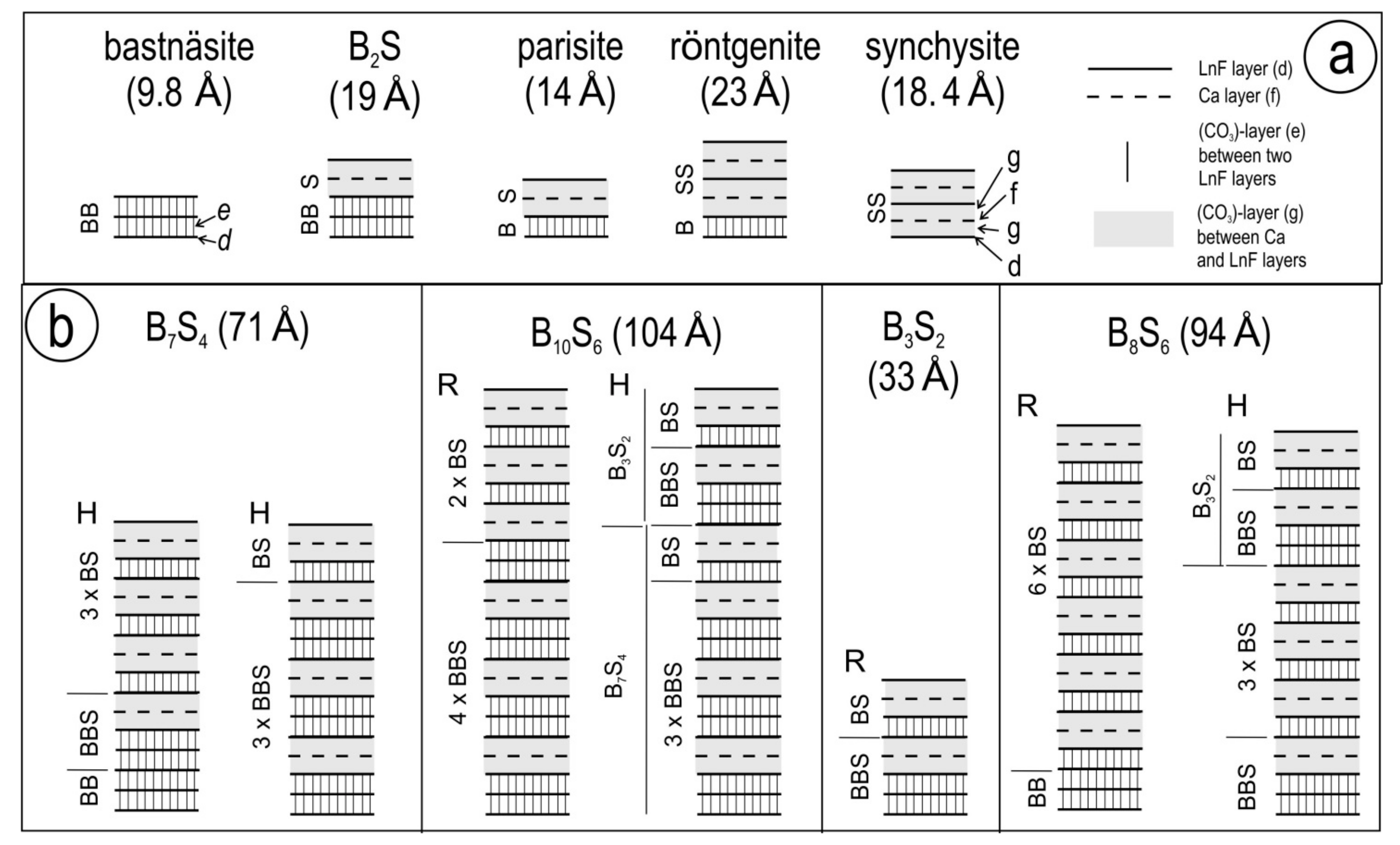
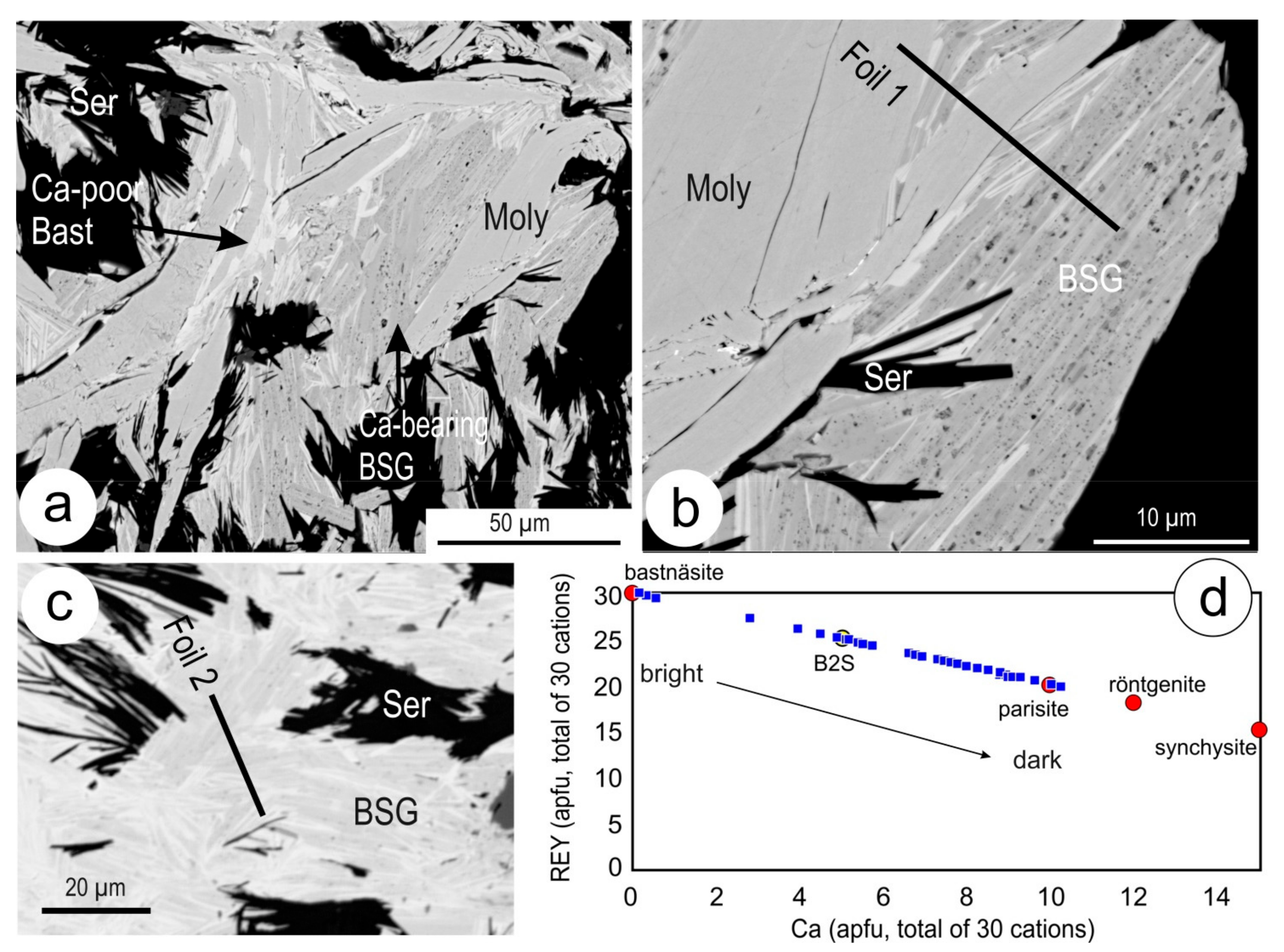
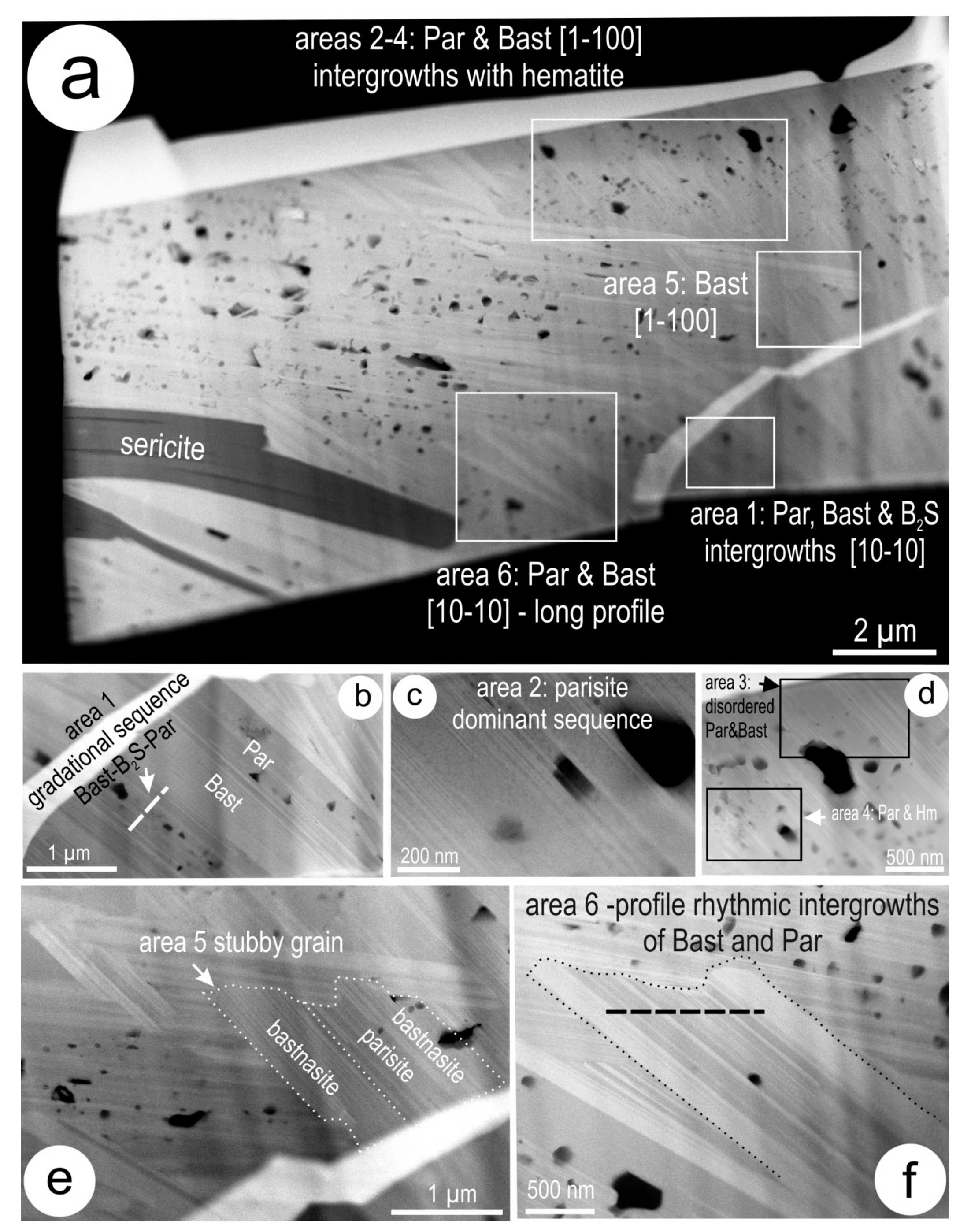
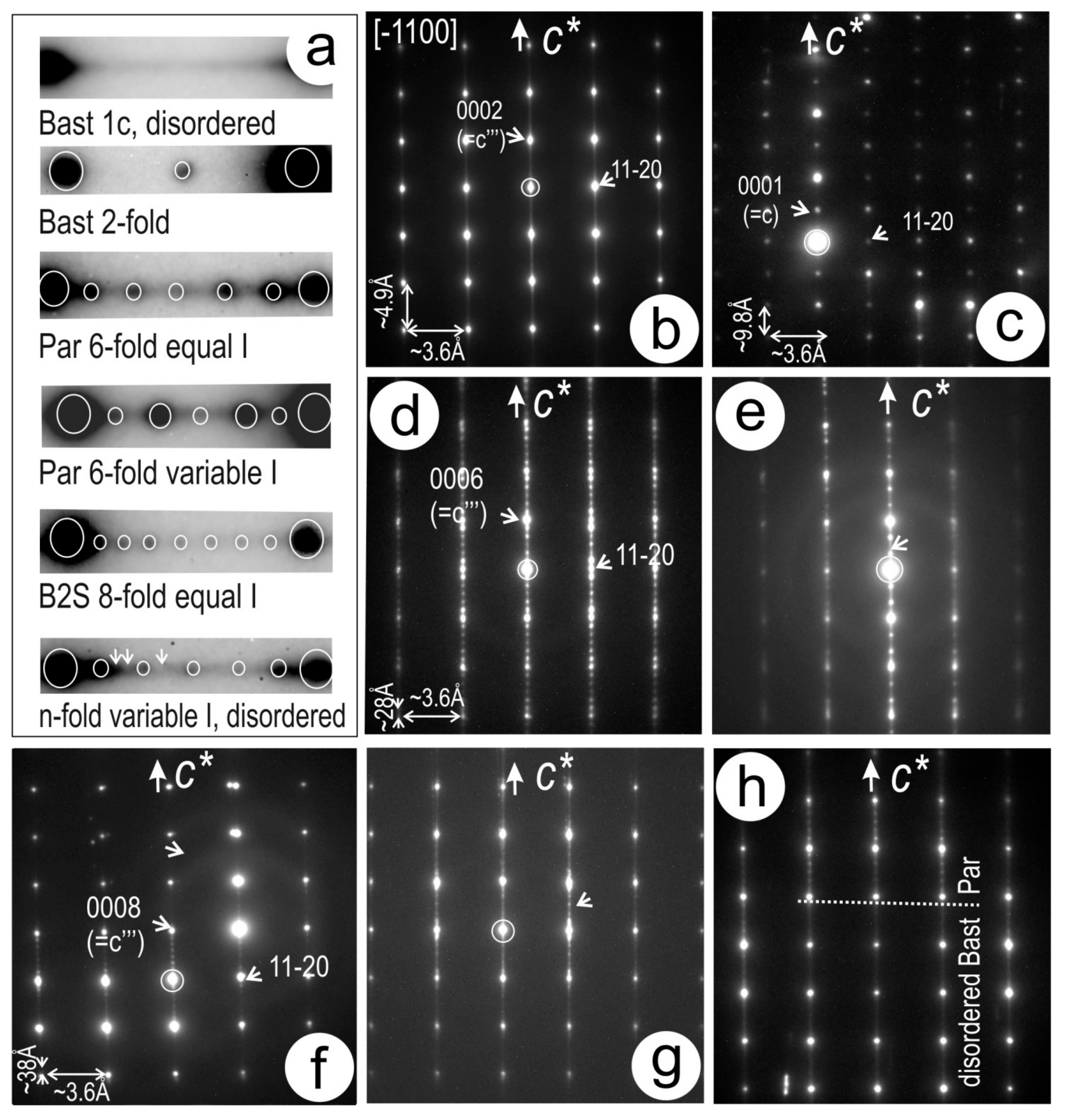
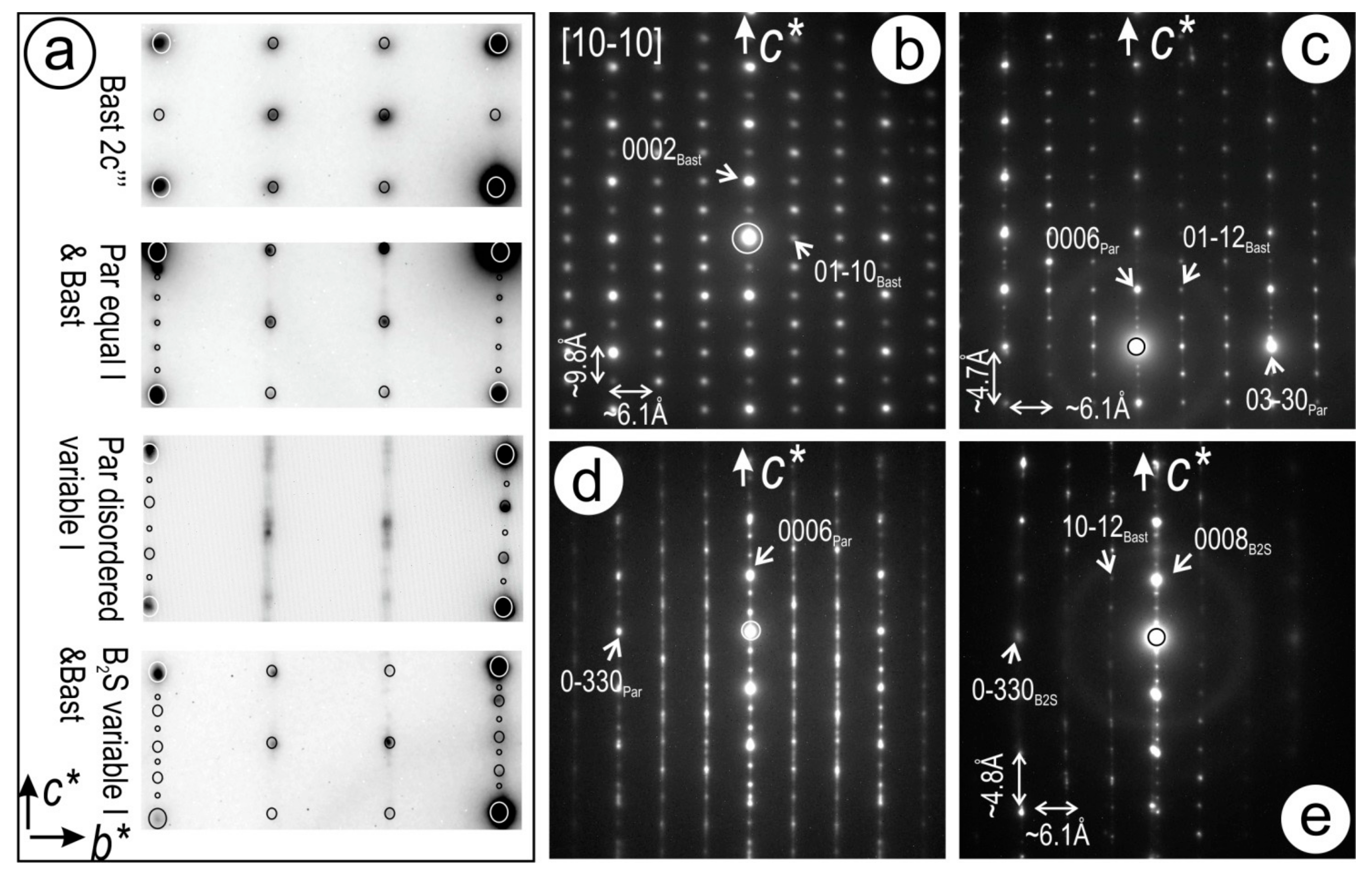



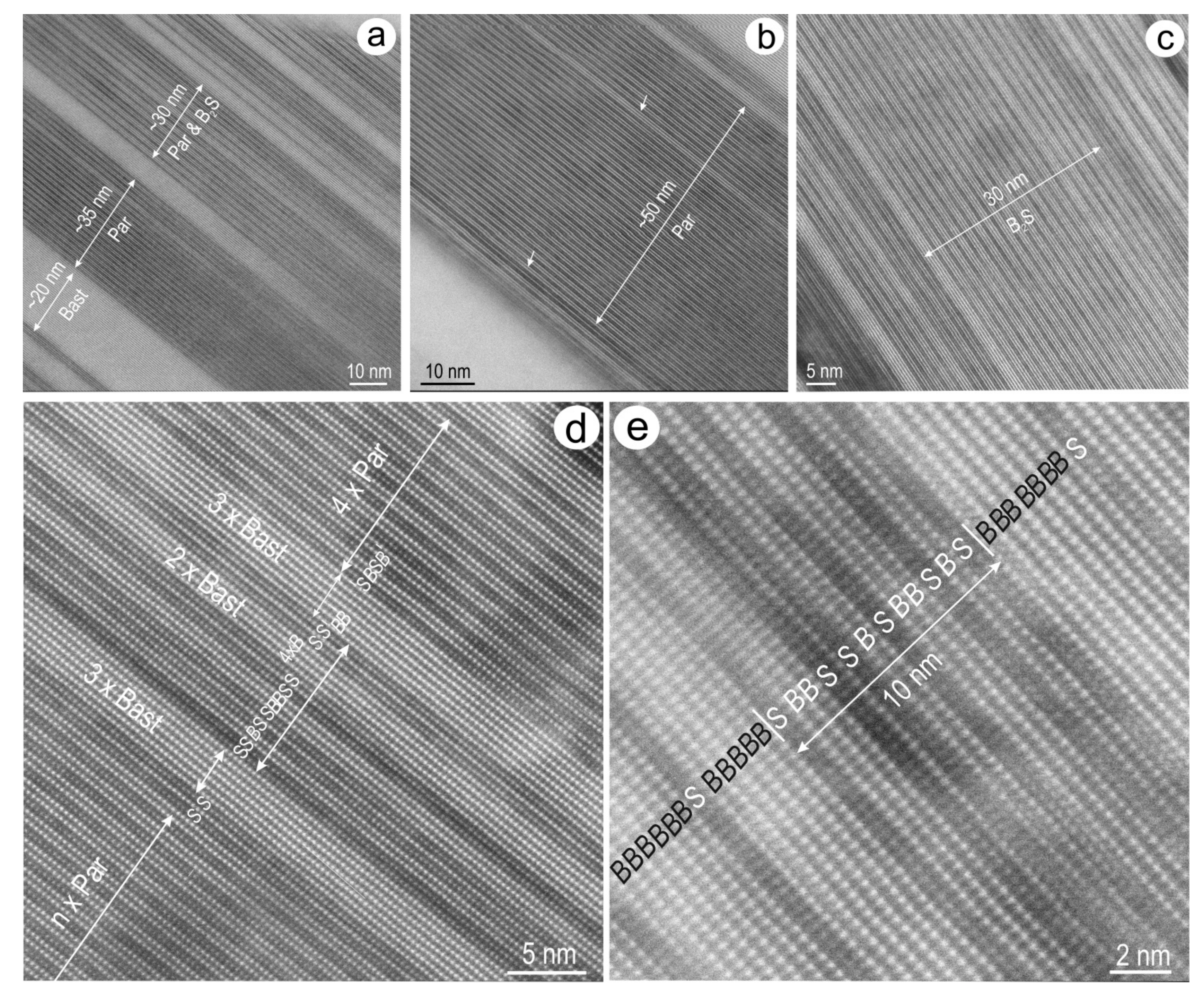
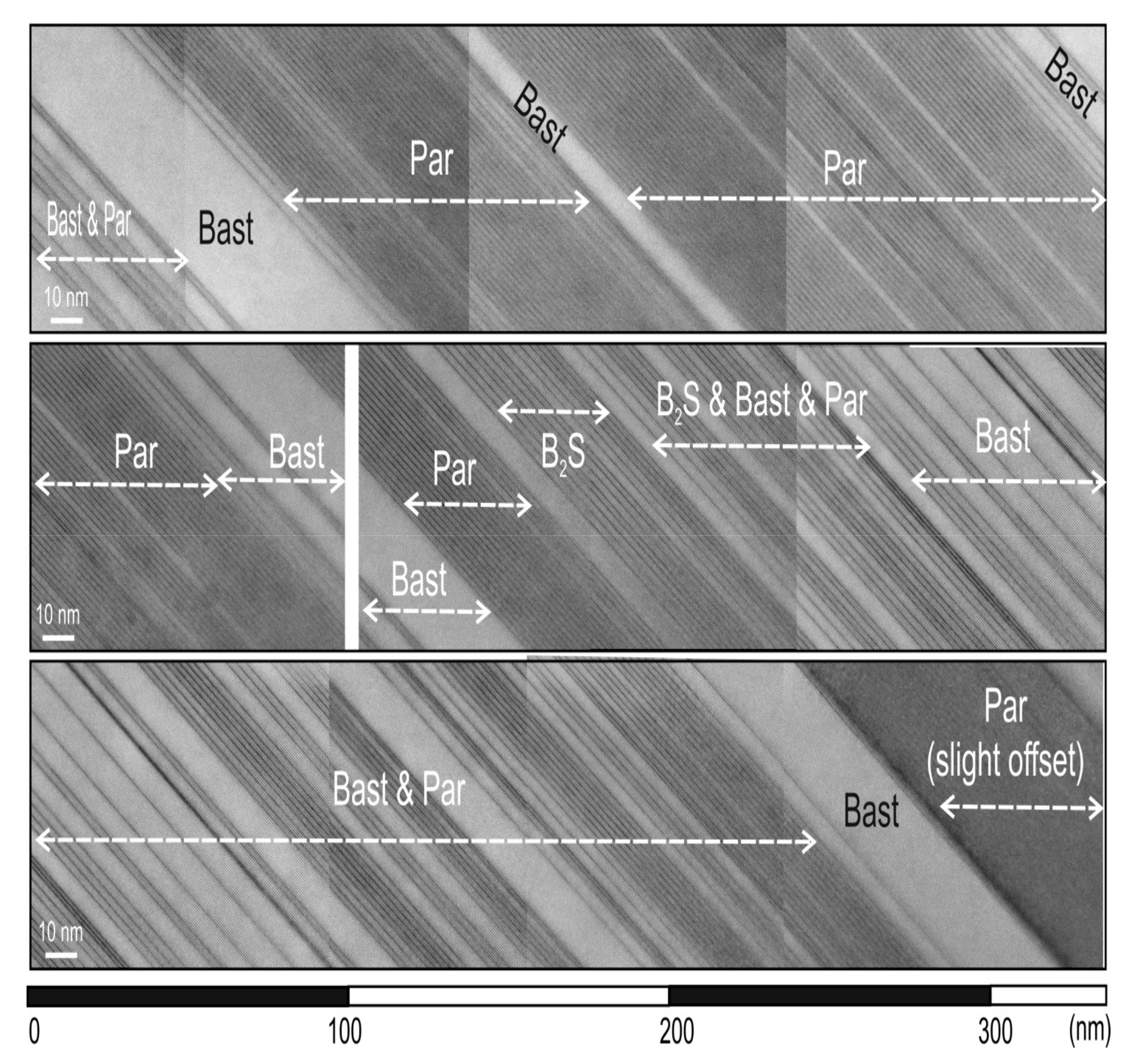

| Name | Formula/Layer Types 1 * (after Ni et al. [17]) | CaCO3 (%) | Slabs | B/S | Layer Types 2 ** (after Donnay and Donnay [15]) | Nsat | Space Group/Symm # | a (Å) | b (Å) | c‴ (Å) | c (x n) (Å); n = number of c‴ | α (º) | β (º) | γ (º) | References |
|---|---|---|---|---|---|---|---|---|---|---|---|---|---|---|---|
| Bastnäsite (B slab) | Ce(CO3)F | 0 | B | de | 2 | P − 62c | 7.16 | 7.16 | 4.89 | 9.79(×2) | 90 | 90 | 120 | [15,17], this study | |
| 1:1:0 | |||||||||||||||
| CaCe3(CO3)4F3 | 25 | B2S | 2 | 2 × (de) ·dgfg | 8 | R, H | 7.13 | 7.13 | 4.71 | 38.4(×8) | 90 | 90 | 120 | [19], this study | |
| 3:3:1 | |||||||||||||||
| Ca4Ce11(CO3)15F11 | 26.7 | B7S4 | 1.75 | 7 × (de)·4 × (dgfg) | 30 | R, H | ~71 | [18] | |||||||
| 11:11:4 | |||||||||||||||
| Ca3Ce8(CO3)11F8 | 27.3 | B10S6 | 1.67 | 10 × (de)·6 × (dgfg) | 44 | R, H | ~104 | [18] | |||||||
| 8:8:3 | |||||||||||||||
| Ca2Ce5(CO3)7F5 | 28.6 | B3S2 | 1.5 | 3 × (de)·2 × (dgfg) | 14 | R, H | ~33 | [16] | |||||||
| 5:5:2 | |||||||||||||||
| Ca3Ce7(CO3)10F7 | 30 | B8S6 | 1.33 | 8 × (de)·6 × (dgfg) | 40 | R, H | ~94 | [18] | |||||||
| 7:7:3 | |||||||||||||||
| Parisite | CaCe2(CO3)3F2 | 33 | BS | 1 | de·dgfg | 6 | R3; H | 7.12 | 7.12 | 4.67 | 14(×3); 28(×6); 84.04(×18) | 90 | 90 | 120 | [15,16,21,22], this study |
| 2:2:1 | Cc | 12.3 | 7.11 | 28.25 | 90 | 98.24 | 90 | [23] | |||||||
| Ca4Ce7(CO3)11F7 | 36.4 | B3S4 | 0.75 | 3 × (de)·4 × (dgfg) | 22 | ~104 | [16] | ||||||||
| 7:7:4 | |||||||||||||||
| Röntgenite | Ca2Ce3(CO3)5F3 | 40 | BS2 | 0.5 | de·2 × (dgfg) | 10 | R3 | 7.13 | 7.13 | 4.62 | 23.1(×5); 69.4(×15) | 90 | 90 | 120 | [15] |
| 3:3:2 | |||||||||||||||
| Ca4Ce5(CO3)9F7 | 44.4 | BS4 | 0.25 | de·4 × (dgfg) | 18 | R, H | ~85 | [16] | |||||||
| 5:5:4 | |||||||||||||||
| Synchysite (S slab) | CaCe(CO3)2F | 50 | S | 0 | dgfg | 4 | O, M, H? | 7.1 | 7.1 | 4.56 | 9.12(×2); 18.2(×4); 54.7(×12) | [15,16] | |||
| 1:1:1 | C2/c | 12.33 | 7.11 | 18.74 | 90 | 102.68 | 90 | [24] |
© 2017 by the authors. Licensee MDPI, Basel, Switzerland. This article is an open access article distributed under the terms and conditions of the Creative Commons Attribution (CC BY) license (http://creativecommons.org/licenses/by/4.0/).
Share and Cite
Ciobanu, C.L.; Kontonikas-Charos, A.; Slattery, A.; Cook, N.J.; Wade, B.P.; Ehrig, K. Short-Range Stacking Disorder in Mixed-Layer Compounds: A HAADF STEM Study of Bastnäsite-Parisite Intergrowths. Minerals 2017, 7, 227. https://doi.org/10.3390/min7110227
Ciobanu CL, Kontonikas-Charos A, Slattery A, Cook NJ, Wade BP, Ehrig K. Short-Range Stacking Disorder in Mixed-Layer Compounds: A HAADF STEM Study of Bastnäsite-Parisite Intergrowths. Minerals. 2017; 7(11):227. https://doi.org/10.3390/min7110227
Chicago/Turabian StyleCiobanu, Cristiana L., Alkis Kontonikas-Charos, Ashley Slattery, Nigel J. Cook, Benjamin P. Wade, and Kathy Ehrig. 2017. "Short-Range Stacking Disorder in Mixed-Layer Compounds: A HAADF STEM Study of Bastnäsite-Parisite Intergrowths" Minerals 7, no. 11: 227. https://doi.org/10.3390/min7110227





